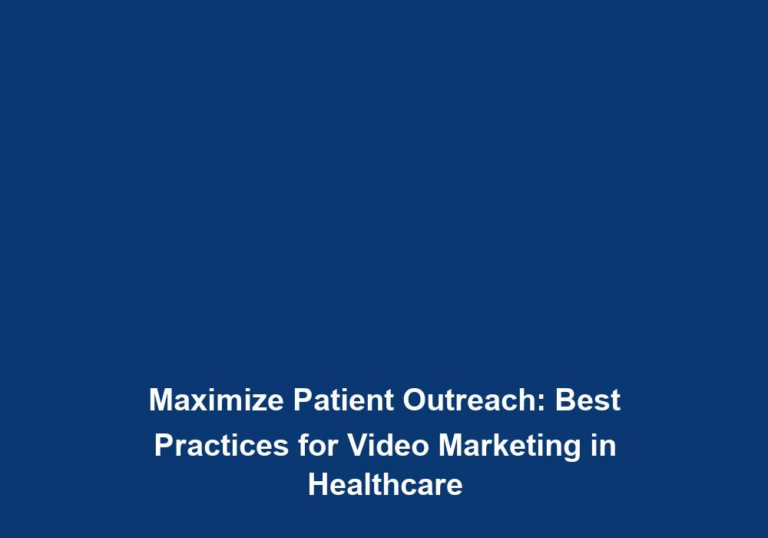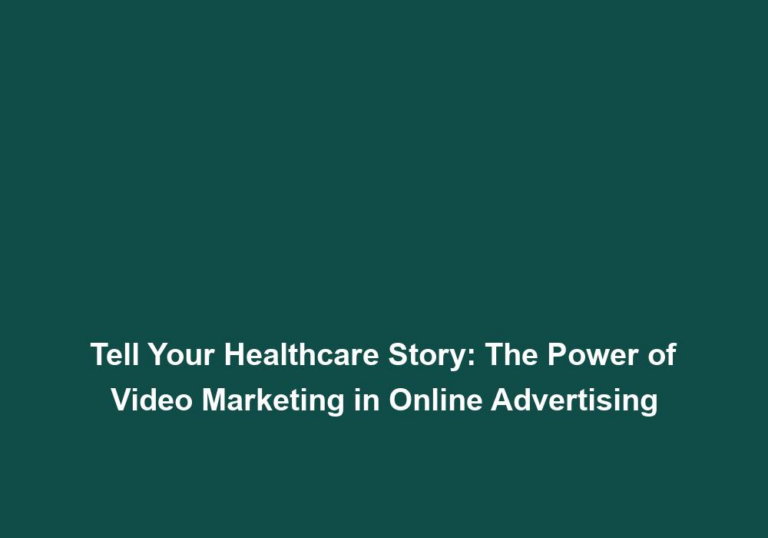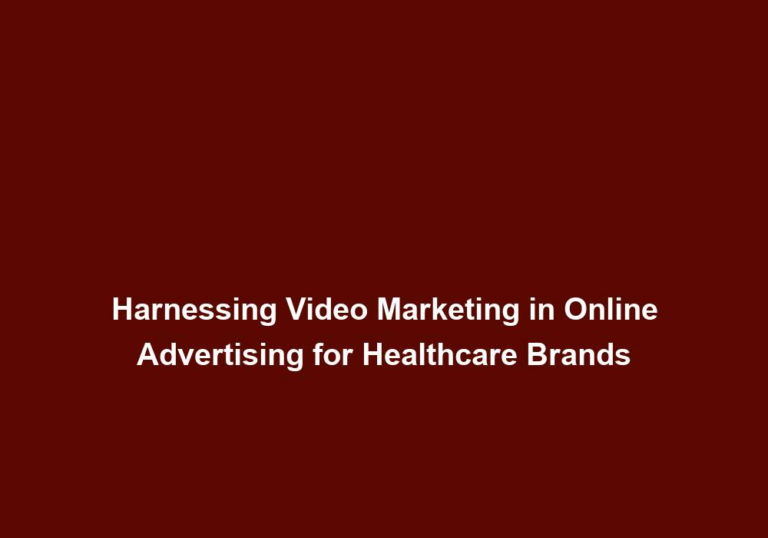Empower Patients with Knowledge: How to Produce Top-Notch Medical Educational Videos
In today’s digital era, video content has become a powerful tool to educate and empower patients. With the increasing availability of high-speed internet and mobile devices, people now have instant access to an abundance of information. However, not all medical information found online is accurate or reliable. This is where producing top-notch medical educational videos can make a significant difference, providing patients with trustworthy content that can empower them to make informed decisions about their health.
The Importance of Medical Educational Videos
- Engaging and Accessible: Medical educational videos are more engaging and accessible than traditional written materials. They combine visuals, audio, and storytelling, making complex medical concepts easier to understand for patients of all ages and backgrounds.
Medical educational videos have the ability to capture and hold the attention of patients, as they combine various elements like visuals, audio, and storytelling. These videos are more engaging than traditional written materials, as they provide a multi-sensory experience that appeals to different learning styles. The use of visuals can help simplify complex medical concepts, making them easier to understand for patients. Additionally, the audio narration and storytelling aspect of videos can create a more immersive experience, increasing the viewer’s understanding and retention of the information presented.
- Reliable Information: With the proliferation of misinformation on the internet, it is crucial to produce medical educational videos that provide accurate and reliable information. By ensuring that the content is evidence-based and reviewed by medical professionals, patients can trust the information presented in these videos.
One of the key advantages of medical educational videos is that they can provide patients with reliable and evidence-based information. In an era where misinformation is rampant on the internet, it is crucial to produce videos that are backed by reputable sources and reviewed by medical professionals. This ensures that the information presented is accurate, up-to-date, and trustworthy. By providing reliable information, medical educational videos can help patients make informed decisions about their health and avoid potential harm caused by misinformation.
- Enhanced Patient-Doctor Communication: Watching medical educational videos can help patients gain a foundational understanding of their medical condition or treatment. This knowledge can improve communication with healthcare professionals, enabling patients to ask informed questions and actively participate in their healthcare decisions.
Medical educational videos can serve as a valuable resource for patients, allowing them to gain a better understanding of their medical condition or treatment. By watching these videos, patients can familiarize themselves with the terminology, procedures, and potential outcomes associated with their healthcare journey. This foundational knowledge can empower patients to actively engage in discussions with their healthcare professionals, asking informed questions and expressing their concerns. Enhanced communication between patients and doctors can lead to more effective and personalized care, as healthcare professionals can better understand the patient’s needs and preferences.
Creating Top-Notch Medical Educational Videos
Producing high-quality medical educational videos requires careful planning, creativity, and expertise. Here are some essential steps and considerations to ensure your videos are effective and impactful:
1. Define Your Target Audience
Understanding your target audience is crucial when creating medical educational videos. Consider the demographics, language preferences, and health literacy levels of your intended viewers. This knowledge will help tailor your content to their specific needs and ensure that it resonates with them on a personal level.
When creating medical educational videos, it is important to have a clear understanding of your target audience. Consider factors such as age, gender, cultural background, and educational level to determine the best approach for delivering the content. For example, if your target audience consists of older adults, it may be beneficial to use simpler language and larger fonts to accommodate their visual and cognitive needs. By understanding your audience, you can create content that is relevant, relatable, and easily understandable, ultimately increasing its impact and effectiveness.
2. Choose Relevant Topics
Select topics that are relevant and important to your target audience. Address common health concerns, medical procedures, preventive measures, or chronic diseases to provide valuable information that patients seek. Conducting keyword research can also help you identify popular topics that people are actively searching for.
To ensure that your medical educational videos resonate with your audience, it is important to choose topics that are relevant and address their specific needs and concerns. Consider conducting keyword research to identify popular topics within your niche. This will help you understand what people are actively searching for and provide valuable information that meets their needs. By addressing common health concerns, medical procedures, preventive measures, or chronic diseases, you can create content that is both informative and engaging, capturing the attention of your target audience.
3. Research and Collaboration
Thoroughly research the chosen topic by consulting medical literature, guidelines, and trusted sources. Collaborate with healthcare professionals, subject matter experts, and patient advocates to ensure accuracy and credibility. Their contributions will add depth and authenticity to your videos.
To produce accurate and credible medical educational videos, it is important to conduct thorough research and consult trusted sources. Review medical literature, guidelines, and reputable websites to gather accurate information and ensure that your content is evidence-based. Collaborate with healthcare professionals, subject matter experts, and patient advocates to gain insights and perspectives that add depth and authenticity to your videos. By involving experts in the creation process, you can ensure that the information presented is accurate, up-to-date, and relevant to your target audience.
4. Script Writing and Storyboarding
Create a well-structured script that outlines the key points you want to convey. Adopt a conversational tone and keep the language simple and jargon-free to enhance understanding. Visualize the video by creating a storyboard, outlining the visuals, animations, and text that will accompany the narration.
A well-structured script is essential for creating effective medical educational videos. Start by outlining the key points you want to convey and organize them in a logical flow. Adopt a conversational tone to make the content more relatable and engaging for your audience. Avoid using complex medical jargon that may confuse or alienate viewers. Instead, use simple and easy-to-understand language to enhance understanding. Visualize the video by creating a storyboard that outlines the visuals, animations, and text that will accompany the narration. This will help you plan the visual elements of your video and ensure that they align with the content and overall message you want to convey.
5. Engaging Visuals and Graphics
Utilize visually appealing graphics, illustrations, and animations to enhance the video’s educational impact. Visual aids can help simplify complex concepts and improve retention. Incorporate clear and concise text overlays to reinforce key messages and provide additional context.
The use of engaging visuals and graphics is key to creating impactful medical educational videos. Visual aids such as graphics, illustrations, and animations can help simplify complex medical concepts, making them easier to understand and remember for viewers. Use visuals that are visually appealing and align with the overall tone and message of your video. Incorporate clear and concise text overlays to reinforce key messages and provide additional context. This will help viewers better understand and retain the information presented in the video.
6. Professional Narration and Voiceover
Hire a professional narrator or voiceover artist with a clear and articulate voice to deliver the script effectively. A well-paced and engaging narration can significantly enhance the viewer’s comprehension and engagement with the video.
The narration of your medical educational videos plays a crucial role in delivering the content effectively. Consider hiring a professional narrator or voiceover artist with a clear and articulate voice to ensure that the information is conveyed clearly and effectively. A well-paced and engaging narration can enhance the viewer’s comprehension and overall engagement with the video. It is important to strike a balance between a conversational tone and a professional delivery to maintain the viewer’s interest while ensuring the credibility of the content.
7. Captions and Translations
Include captions in your videos to make them accessible to individuals with hearing impairments. Additionally, consider translating your videos into different languages to reach a wider audience and cater to diverse patient populations.
To ensure that your medical educational videos are accessible to a wider audience, consider including captions in your videos. Captions make the content accessible to individuals with hearing impairments, allowing them to follow along and understand the information presented. Additionally, consider translating your videos into different languages to reach a broader audience. This will ensure that individuals who may not understand the original language can still benefit from the educational content. By making your videos accessible and inclusive, you can empower a diverse range of patients to make informed decisions about their health.
8. Optimization for Search Engines
To ensure your medical educational videos reach a wider audience, optimize them for search engines. Conduct keyword research and incorporate relevant keywords in your video titles, descriptions, and tags. This will improve the visibility of your videos in search engine results, increasing their reach and impact.
Optimizing your medical educational videos for search engines is essential to increase their visibility and reach a wider audience. Conduct keyword research to identify relevant keywords and phrases that are commonly used by individuals searching for medical information. Incorporate these keywords in your video titles, descriptions, and tags to improve their visibility in search engine results. By optimizing your videos, you can increase the chances of reaching individuals who are actively seeking reliable and informative medical content, ultimately empowering them with knowledge.
9. Promote and Share
Once your medical educational videos are ready, promote and share them across various platforms. Utilize social media, healthcare websites, patient portals, and email newsletters to reach your target audience. Encourage viewers to share the videos with others, maximizing their impact.
Promotion and sharing are crucial steps in ensuring that your medical educational videos reach your intended audience. Utilize various platforms such as social media, healthcare websites, patient portals, and email newsletters to promote and share your videos. Tailor your promotional efforts to reach your target audience effectively. Encourage viewers to share the videos with others, as word-of-mouth can significantly increase the reach and impact of your content. By actively promoting and sharing your videos, you can maximize their visibility and empower more patients with valuable knowledge.
10. Monitor and Update
Regularly monitor the performance and feedback of your medical educational videos. Analyze metrics such as views, engagement, and comments to gauge their effectiveness. Consider updating and refreshing your videos periodically to ensure the information remains accurate and up to date.
Monitoring the performance of your medical educational videos is essential to understand their impact and effectiveness. Analyze metrics such as views, engagement, and comments to gain insights into how well your videos are resonating with your audience. Pay attention to viewer feedback and comments, as they can provide valuable insights for improvement. Consider updating and refreshing your videos periodically to ensure that the information remains accurate and up to date. This will help maintain the credibility of your content and ensure that it continues to provide value to your audience.
By following these steps and incorporating best practices, you can produce top-notch medical educational videos that empower patients with knowledge and contribute to their overall well-being. Remember, the primary goal of these videos is to provide accurate, reliable, and patient-centered information. By doing so, you can play a pivotal role in helping patients make informed decisions about their health and improve their overall healthcare experience.







